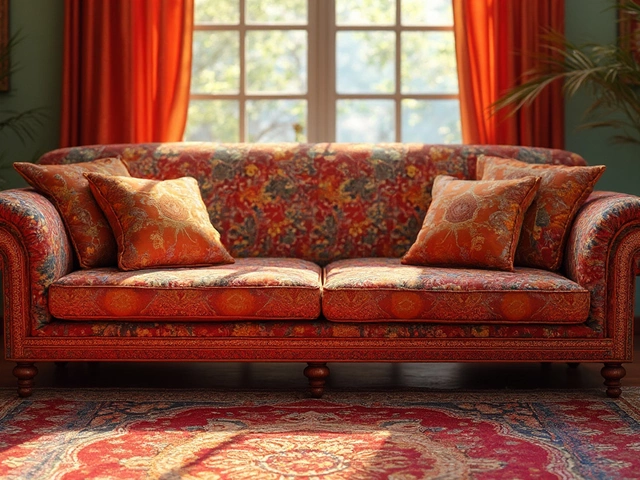If you're on the hunt for that perfect sofa cushion foam, you're in the right place! Ever sat on a sofa that felt like a cloud and wondered what magic was hidden inside those cushions? Well, it often boils down to what's inside.
Choosing the right foam is no small feat. The material inside your sofa cushions is crucial to how comfortable they feel, how well they wear over time, and how much they support your posture. There's more to sofa cushion foam than meets the eye.
When talking about cushion foam, density and firmness are key factors. But did you know that the best choice often depends on how you plan to use your sofa? For casual lounging, a softer, perhaps a memory foam might rise to the occasion. For something that retains shape and offers firm support, high-density foam could be the way to go.
- Understanding Sofa Cushion Foam
- Memory Foam: Pros and Cons
- High-Density Foam: A Popular Choice
- Latex Foam: Durability and Comfort
- Factors to Consider When Choosing Foam
- Tips for Maintaining Sofa Cushions
Understanding Sofa Cushion Foam
When it comes to sofa cushion foam, not all are created equal. The world of foam is diverse, offering options with different densities, firmness, and materials. Your choice can directly affect your seating comfort and the sofa’s durability.
What is Sofa Cushion Foam?
In a nutshell, sofa cushion foam is the “stuffing” that goes into the cushions of your couch. It determines how soft or firm your sofa feels and how well it holds up over time. With so many choices available, it can be a bit overwhelming to pick the right foam.
Types of Foam
Here are common types you'll come across:
- Memory Foam: Popular for its ability to contour to the shape of your body. It provides luxury and comfort, though it might not be the most durable if heavily used.
- High-Density Foam: As the name suggests, it’s denser than other foams. It offers great support and tends to be quite durable, making it ideal for regular use.
- Latex Foam: This is another durable option that offers a good mix of support and comfort. It's naturally resistant to mold and dust mites, which is a big plus for allergy sufferers.
Density and Firmness
Density refers to the foam's mass per unit volume. Generally, the higher the density, the more durable the foam will be. Firmness, on the other hand, is how the foam feels when you sit on it. You can have high-density foam that's soft or firm based on your preference.
Why Does It Matter?
Picking the right foam influences not just the comfort, but also the lifespan of your sofa. You wouldn't want a sofa cushion that sags after a few months, right? Investing in good quality foam might cost a bit more initially, but it pays off in the long run.
Whether you're sprucing up your old sofa or buying a new one, understanding the types of sofa cushion foam can help you make a wiser choice. After all, your sofa is a significant piece of your living space and deserves careful consideration!
Memory Foam: Pros and Cons
Let's chat about memory foam—the stuff that's all about comfort and moldability. Have you ever plopped down on a sofa and felt like it was hugging you right back? That's likely memory foam in action.
Pros of Memory Foam
- Comfort and Support: Memory foam contours to your body, offering personalized support that can reduce pressure points. It's like sitting on a custom-fitted cushion!
- Durability: High-quality memory foam tends to be pretty durable. Even after repeated use, it often returns to its original shape.
- Adaptability: This foam adjusts perfectly to different body weights and shapes, making it a popular choice for a family sofa.
- Great for Allergy Sufferers: Many memory foams are hypoallergenic, an absolute win for those dealing with allergies.
Cons of Memory Foam
- Heat Retention: Memory foam can hold onto body heat, which might not be ideal in warmer climates. Without gel or ventilation features, you might find it a tad warm.
- Cost: It's often pricier than other types of foam. The comfort and longevity are great, but you might need to splurge a bit.
- Initial Chemical Smell: When new, some memory foam cushions might have a slight 'off-gassing' odor. It typically fades, but it's worth noting for those sensitive to smells.
Memory foam is generally loved for its unique combination of comfort and support. If these pros tick your boxes, it could be the perfect match for your cozy nights in.
High-Density Foam: A Popular Choice
When it comes to sofa cushions, high-density foam has become a staple choice for many homeowners. But why is this the case? It's largely because of its combination of durability and comfort, making it ideal for heavy-use areas.
First off, what exactly is high-density foam? In simple terms, it refers to foam with a higher weight per cubic foot, which generally translates to better support and a longer lifespan. So, if you’re someone who loves to lounge on the couch after a long day, this foam can withstand those countless hours of chilling.
Benefits of High-Density Foam
There are quite a few perks to choosing high-density foam. Here are some compelling reasons:
- Support: It provides strong support, keeping your cushions from going flat over time.
- Durability: It typically lasts longer than lower-density foams, meaning you won't have to replace it anytime soon.
- Comfort: Offers a firm yet comfortable feeling, providing a solid seating experience.
Things to Consider
However, it's not all sunshine and rainbows. Here are a few factors to ponder over:
- Cost: High-density foam can be pricier than its lower-density counterparts, but think of it as an investment.
- Weight: It’s heavier, which could make moving your sofa around a bit more challenging.
Making a Choice
In terms of sofa cushions, the choice often boils down to how you use them. For families with young kids or homes with frequent gatherings, the resilience of high-density foam can be a game-changer.
If you want extra numbers, here’s a quick look:
| Foam Density (lbs/ft³) | Average Lifespan (years) |
|---|---|
| 2.5 - 3 | 5 - 7 |
| Above 3 | 8 - 10 |
Deciding on high-density foam can boost your sofa’s comfort and longevity, so weigh your options carefully.

Latex Foam: Durability and Comfort
When it comes to sofa cushions, latex foam often stands out thanks to its bouncy feel and long-lasting nature. It's a fantastic choice if you're all about comfort without compromising durability. Latex is derived either naturally from rubber trees or synthetically, and it can offer a cozy, springy feel to your sitting experience.
One of the big wins for latex foam lovers is its ability to hold its shape over time. Unlike some other types of sofa cushion foam that might sag or indent with frequent usage, latex stays resilient. This means your sofa looks plush and feels supportive for years.
Why Latex Foam is a Strong Choice
There are a couple of things that really make latex foam shine:
- Durability: This foam naturally bounces back, resisting wear and tear that come with regular use. It's an investment in maintaining that neat, structured look.
- Breathability: Latex has great airflow, which means it doesn’t hold heat. No more sitting on a cushion that feels like it was baking in the sun!
- Hypoallergenic Properties: Natural latex is resistant to dust mites, which is a big plus for those prone to allergies.
A Bit of Budget Talk
Now, while latex foam brings a lot to the table, it might give your wallet a bit of a workout. It's generally more expensive compared to other types of foam, but given its longevity, many see it as worth the cost.
Comparing Latex with Other Foams
| Foam Type | Durability | Comfort |
|---|---|---|
| Latex Foam | High | High |
| Memory Foam | Medium | High |
| Polyurethane Foam | Low | Medium |
There you have it! Latex foam offers an excellent blend of comfort and durability that can keep your sofa cushions in top shape for the long haul. It might be worth considering if longevity and comfort are on your checklist when picking out sofa cushion types.
Factors to Consider When Choosing Foam
Picking the right sofa cushion foam isn't just about grabbing the first one that feels nice in the store. It's a bit more of a science, really. Here are some of the things you should weigh up before making a choice.
Density and Firmness
The density of the foam greatly impacts durability and support. Higher density often means the cushion will keep its shape longer, but it might also feel firmer. Picture this: lounging on a cushion that maintains its form even after a lot of use. That's the magic of high-density foam. Memory foam, on the other hand, adapts to your shape, which can feel very comfy, but it might not pop back as quickly.
"The industry standard for high-quality cushion foam usually ranges from 1.8 to 3.0 pounds per cubic foot in density depending on the type of seating," says Furniture Today.
Usage
Consider who's going to be using the sofa and how often. If you have a family that enjoys binge-watching series or if you host guests frequently, durability is key. In these cases, high-density foam might be your best bet. Conversely, if you like sofas for quick cat naps, a softer foam like memory foam might be more to your liking.
Allergies and Sensitivities
This is super important. Latex foam, for instance, is naturally hypoallergenic and resistant to dust mites, which makes it a great choice if allergies are a concern. In contrast, traditional foam might accumulate allergens over time without proper maintenance.
Budget
Let's get real, budget matters. Sometimes the fanciest option isn't practical, and thankfully, there's a range of foam types at different price points. You don't have to break the bank for comfort.
Foam Lifespan
Getting familiar with the expected lifespan of different foams can also save you some future headaches. Some premium foams can last up to 10 years, offering good value over time, while others might need to be replaced more frequently.
| Type of Foam | Density (lbs/cubic ft) | Average Lifespan (years) |
|---|---|---|
| High-Density Foam | 2.5 - 3.0 | 7-10 |
| Memory Foam | 1.5 - 2.5 | 5-7 |
| Latex Foam | 3.0 - 5.0 | 8-12 |
In the end, it all boils down to balancing your comfort needs with practical considerations like budget and durability. Make a wise choice now, and your future self will thank you each time you sink into that cozy sofa cushion.
Tips for Maintaining Sofa Cushions
Keeping your sofa cushions looking and feeling great isn't rocket science, but a bit of proactive care can go a long way. Let’s ensure your cushions are always ready to provide the comfort you deserve.
1. Regular Fluffing and Rotation
Fluff your cushions regularly to keep them from flattening. A quick shake every now and then can help maintain their shape. Rotating the cushions can evenly distribute wear and tear, especially those made of memory foam or high-density foam.
2. Clean Spills Immediately
Accidents happen, especially if you've got kids or pets around. If someone spills something on your sofa, address it ASAP. Use a clean cloth to blot (not rub) the stain to prevent it from setting. Make sure to check the cushion care label for guidance on cleaning solutions that are safe to use.
3. Vacuum Regularly
Dust, crumbs, and pet hair can nestle in your cushions, so give them a good vacuum weekly. Use a soft brush attachment to avoid damaging the fabric.
4. Keep Away From Direct Sunlight
Exposing your sofa to direct sunlight can fade colors and weaken fibers over time. Keep your awesome cushions away from direct sunlight or use throws to cover them when not in use.
5. Consider Protective Covers
Using removable, washable covers can protect against spills, dust, and the general grime that accumulates over time. Plus, they give you flexibility if you want to switch up your living space's look.
6. Be Mindful of Foam Quality
Invest in quality cushion foam like sofa cushion foam made to withstand everyday use. High-quality foam will last longer and provide better support.
By following these practical tips, your cushions can stay fresh and comfy for years to come, offering the perfect spot to unwind after a tiring day.





